2018 School Spending Survey Report
OSU Libraries Offer Open Access Etextbooks to Students
Oregon State University (OSU) is helping faculty produce their own open access textbooks for courses. The university press, an arm of the OSU libraries, is starting work on a series of open source e-textbooks that officials hope will ease the rising textbook costs that are a consistent cause of student complaints. To make the etextbook program work, the library and press are partnering with OSU’s Ecampus program, which administers distance and online learning programs for the college.

The Valley Library at OSU - Wikimedia Commons
Oregon State University (OSU) is helping faculty produce their own open access textbooks for courses. The university press, an arm of the OSU libraries, is starting work on a series of open access e-textbooks that officials hope will ease the rising textbook costs that are a consistent cause of student complaints. To make the etextbook program work, the library and press are partnering with OSU’s Ecampus program, which administers distance and online learning programs for the college. OSU library director Faye Chadwell, whose background is in collections management, said the collaboration gives libraries a new way to help students with the cost of textbooks, and one that is meaningful compared to offering books on reserve, a “drop in the bucket” solution that she said doesn’t scale effectively to meet demand. “I’m used to student groups coming in and asking if we can help with the cost of books,” Chadwell told Library Journal. “Now that we’re in a position where libraries have begun to look at the possibility of publishing services, and especially when you have a press present in the library, we can do more.” Depending on the subject, students could save anywhere from $50 to $250 by using an open access etextbook instead of a traditional print one. Chadwell also pointed out that the new texts are designed with modularity in mind, noting that students are regularly required to purchase textbooks for a course only to learn they will only read a chapter or two during the class. To bring the project to fruition, Chadwell and the OSU library took advantage of the tech savvy of their partners in the Ecampus program to take advantage of the electronic format to make these new textbooks more than just traditional tomes. The ebook format not only gave OSU a chance to make ebooks that were well suited for students in the university’s distance learning programs, but also let them go beyond simply text and words, bringing to bear interactive elements. As a proof of concept, the collaboration started with an existing textbook, OSU geology professor Robert S. Yeats’ Living with Earthquakes in the Pacific Northwest. Yeats, who was already working on an update to the book, allowed OSU press and Ecampus to use the book as a prototype for the program, expanding on the content and making it more interactive. “This gives us opportunity to add animation and new media, and earthquakes make for good visual possibilities, said OSU Ecampus director of emerging technologies Dianna Fisher. “It gave us the opportunity to replace some stills and charts with interactive multimedia.” The etextbook edition of Living with Earthquakes in the Pacific Northwest will be available later this spring, with further offerings on topics like biochemistry and animal husbandry to follow in the fall. The new etextbooks will be authored by OSU faculty, and Chadwell points out that many are already using the content that will become new textbooks in their classes. Faculty won’t receive royalties on the books, aside from the possibility of some small fees for print-on-demand copies of the works, meaning Yeats has relinquished his royalties on the newest edition of Living with Earthquakes, which is used in courses not only at OSU, but in universities across the region. Of course, even without printing costs, creating new textbooks isn’t free. Taken together with the fact that the etextbooks won’t generate any money for the university that means the program will have to be picky about how many options it offers. “We can’t do hundreds of new textbooks, but we can contribute in areas that make sense to OSU,” said Chadwell, who hopes to eventually see the OSU published etextbooks follow the Living with Earthquakes models and be used in other universities, as well. “The press can come in and say ‘This would be a good textbook because we can market it as something unique.’” Only time will tell if even that model is sustainable, but Chadwell said she would be open to looking at consortium models of publishing these etextbooks, especially considering neighboring Washington and California are already providing state money to colleges and universities in the interest of producing more open access texts. She’s also hopeful that the program could reach outside of the realms of higher education. “You don’t have to be studying geology,” Chadwell said of Living with Earthquakes. “It will be interesting to people living in the northwest, and that supports our land grant mission of pushing information out to the general public.”RELATED
RECOMMENDED
TECHNOLOGY
ALREADY A SUBSCRIBER? LOG IN
We are currently offering this content for free. Sign up now to activate your personal profile, where you can save articles for future viewing









Add Comment :-
Comment Policy:
Comment should not be empty !!!